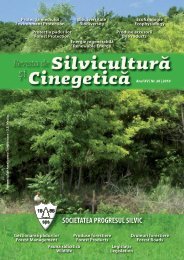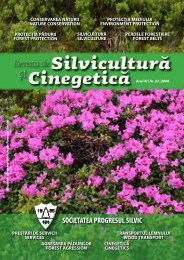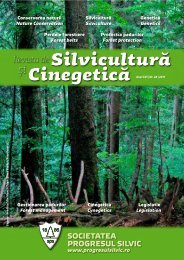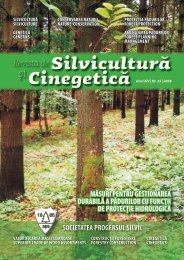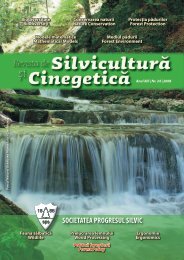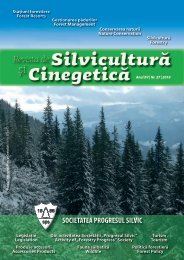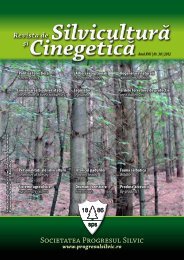Silviculture and Cinegetics Review - Societatea Progresul Silvic
Silviculture and Cinegetics Review - Societatea Progresul Silvic
Silviculture and Cinegetics Review - Societatea Progresul Silvic
Create successful ePaper yourself
Turn your PDF publications into a flip-book with our unique Google optimized e-Paper software.
FORESTRY BELTS SILVICULTURE AND CINEGETICS REVIEW XVII/30/2012<br />
impact on woody vegetation <strong>and</strong> fauna, the appearance<br />
of pests <strong>and</strong> diseases in high density, which affect<br />
Photo 3. Wild ungulates<br />
The result was an alarming increase in ungulate density<br />
(sometimes up to 50 deer/km 2 ). This imbalance led to<br />
new problems relating to sustainability, due to the<br />
livestock, including humans, decreased genetic diversity<br />
etc., <strong>and</strong> new concepts of l<strong>and</strong> management. Hare<br />
densities have suffered a dramatic decline due to<br />
myxomatosis, a viral hemorrhagic disease, <strong>and</strong><br />
predators. It therefore became a major issue because<br />
wild hare is the main prey for many predators (including<br />
the Iberian imperial eagle <strong>and</strong> the lynx), <strong>and</strong> scavengers<br />
(black eagle). Partridge, another traditional hunting<br />
species, is endangered due to problems caused by the<br />
release of captive-bred populations (affected by pests,<br />
diseases <strong>and</strong> sometimes with different genetic fund) <strong>and</strong><br />
predators (wild boar). Finally, the number of wild<br />
pigeon populations increased, even if they compete<br />
with domestic animals (especially the Iberian pig) <strong>and</strong><br />
wild ungulates for acorns (Table 9).<br />
Table 9. Characteristics of wildlife species in dehesa (by Olea <strong>and</strong> San Miguel, 2006)<br />
Role<br />
Primary production in many cases<br />
Species<br />
Wild ungulates : red deer ( Cervus elaphus hispanicus), wild boar (Sus scrofa), deer( Capreolus capreolus) , roe<br />
deer (Dama dama), mouflon (Ovis ammon musimon), rabbit (Oryctolagus cuniculus), hare (Lepus granatensis),<br />
partridge ( Alectoris rufa), wild pigeon ( Columba palumbus), turtle dove (Streptopelia turtur), <strong>and</strong> many others<br />
Exploitation rate Ungulates: 10-20 ind/km 2 . Problems with overgrazing<br />
Hare: normal 10 ind/ha. It disappeared from many dehesa <strong>and</strong> now has much lower density.<br />
Partridge: variable density depending on food <strong>and</strong> shelter<br />
Wild pigeon: high density in autumn <strong>and</strong> winter, where there are acorns. L<strong>and</strong>owners often scare them away in<br />
order to keep the acorn reserve for wild animals <strong>and</strong> ungulates.<br />
Management Wild ungulates: usual practice is “monteria” (individuals are driven by hunters with dogs) <strong>and</strong> less common,<br />
feeders. Hunting solvency: 15-20% except wild boar (higher, sometimes 100%, or more).<br />
Hare <strong>and</strong> bird species: protected. Partridge is hunted by “ojeo” (individuals are being driven to fall within<br />
hunter’s fire range).<br />
2. 6. Environment protection<br />
Dehesa is an ecosystem protected by the law 92/43/EEC<br />
of the Directiva Habitate, <strong>and</strong> included in the Natura<br />
2000 network. In addition, it includes a variety of<br />
services or benefits to the environment: biodiversity,<br />
ecosystem resilience (erosion, climate, biogeochemical<br />
circuits, fire, etc.), l<strong>and</strong>scape, recreation, tourism,<br />
cultural heritage <strong>and</strong> more. Dehesa is at the same time<br />
habitat for many species of protected plants <strong>and</strong> animals<br />
<strong>and</strong> communities. As a consequence, despite the fact<br />
that it often lies on private property, environmental<br />
protection should be considered as a fundamental<br />
objective of all possible types of management.<br />
Environmental quality is a result of expansion of<br />
.<br />
integrated environmental management, <strong>and</strong> this<br />
management should be considered as a conservation<br />
tool. As an example of the importance of agroforestry<br />
management is the activity of the LIFE project whose<br />
purpose is to preserve the Iberian lynx, Iberian imperial<br />
eagle, black eagle <strong>and</strong> black stork. The conclusion is<br />
that this type of management, whose profitability is<br />
lower, must be supported by the European <strong>and</strong> Spanish<br />
governments. Coverage degree <strong>and</strong> distribution of<br />
st<strong>and</strong> proved to be a crucial factor in the determinism of<br />
population diversity <strong>and</strong> density of many animal groups<br />
of the dehesa ecosystem. It is well known its<br />
importance for domestic animal species, ungulates,<br />
micro-mammals <strong>and</strong> birds, also demonstrated for lizards<br />
<strong>and</strong> certain species of beetles<br />
80



